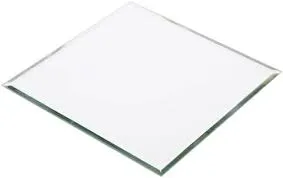

Understanding Beveled Low-E Glass A Perfect Blend of Aesthetics and Efficiency
In the realm of architectural design and energy efficiency, glass plays a crucial role. Among the many types of glass available today, beveled low-emissivity (Low-E) glass stands out for its unique combination of aesthetic appeal and energy-saving properties. This article explores what beveled low-E glass is, its benefits, and its applications in modern architecture.
What is Beveled Low-E Glass?
Beveled low-E glass is a special type of glass that features a sloped edge or bevel along its perimeter. This design not only enhances the visual appeal of the glass but also avoids the jagged edges typical of standard glass. The term “low-E” refers to the microscopic metallic coating applied to one side of the glass, which reflects infrared light to keep heat inside during winter and outside during summer, thereby improving energy efficiency.
The beveling process adds a layer of sophistication to the glass, creating an optical illusion that can refract light beautifully. This makes beveled low-E glass particularly popular for decorative windows, glass doors, and even skylights, where aesthetics are just as important as functionality.
Benefits of Beveled Low-E Glass
1. Energy Efficiency One of the primary benefits of low-E glass is its ability to reduce energy consumption. By reflecting radiant heat, it minimizes the load on heating and cooling systems. This leads to lower utility bills and a smaller carbon footprint, making it an environmentally friendly option.
2. UV Protection Low-E glass also offers superior protection against harmful ultraviolet (UV) rays. This is particularly important for homes and businesses that wish to protect furnishings, artwork, and flooring from fading due to sun exposure. The coating blocks a significant amount of UV radiation, enhancing the longevity of items inside.
3. Aesthetic Versatility The beveled edge design adds a refined touch to any structure. Whether used in modern architecture or traditional designs, beveled low-E glass enhances the overall appearance of a space. It can be customized to fit various architectural styles, thus providing the flexibility that architects and designers desire.

4. Noise Reduction Beveled low-E glass can also contribute to noise reduction. The multi-pane construction often associated with low-E glass windows can help dampen outside sounds, providing a more peaceful indoor environment. This is especially beneficial in urban settings or near busy roads.
5. Increased Property Value Incorporating beveled low-E glass into a home can enhance its aesthetic value and energy efficiency, making it more attractive to potential buyers. This can lead to an increase in property value, as energy-efficient homes are increasingly sought after.
Applications in Modern Architecture
Beveled low-E glass is versatile and finds applications in various architectural projects. It is commonly used in
- Residential Buildings Homeowners often choose beveled low-E glass for windows, sliding doors, and decorative features. Its elegant appearance complements both contemporary and classic designs.
- Commercial Properties Businesses use beveled low-E glass in storefronts, office buildings, and corporate structures. The glass not only enhances visibility and displays products effectively but also contributes to energy savings, which is crucial for many businesses.
- Skylights and Sunrooms Beveled low-E glass can be particularly beneficial for skylights and sunrooms, allowing natural light to flood into a home while minimizing heat loss and glare.
Conclusion
Beveled low-E glass represents an innovative solution that marries style with function. As energy efficiency becomes a priority in both residential and commercial construction, the appeal of this type of glass continues to grow. With its ability to reduce energy costs, protect interiors from UV damage, and enhance aesthetic value, beveled low-E glass is undoubtedly an essential component of modern architectural design. Whether you're an architect, a builder, or a homeowner, considering beveled low-E glass can be a smart choice for both today and the future.